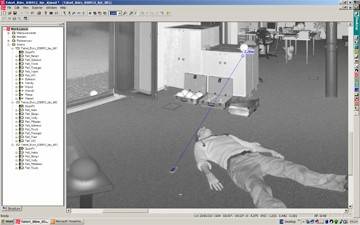Laser scanning is rapidly gaining acceptance and becoming more and more commonplace in the law enforcement and accident reconstruction communities. Over the past few years, hardware and software have improved significantly creating a simpler, overall system to capture immense detail in a short period of time.
These are 10, of the many, reasons to consider laser scanners for a forensic application:
1) Easy to use: Many manufacturers are moving toward a simpler interface making operation of the scanner more like a digital camera than a complicated survey instrument.
2) Portability: Laser scanners are smaller in size today than ever before making them easier to deploy to a crime/accident scene and useable by just about anyone.
3) Safety: Data can be collected from a distance, with some scanners collected measurements over 300 meters away. This allows the operator to scan a scene out of harms way. In addition, laser scanners can collect up to 1,000,000 points per second with average scan times of several minutes. Less time on a scene means less time for potential danger to the individuals at the scene. Class I lasers are also being used in laser scanners creating a truly eye-safe environment during the scan.
4) Speed and Efficiency: Complete color scans can be captured in as little as several minutes creating a virtual scene with high accuracy and detail that can be revisited over and over without physically traveling to the site. In contrast to traditional methods of surveying/documenting a scene, laser scanning can be much faster and allow multiple investigators to have eyes on the virtual scene.
5) Produce a variety of deliverables: Once the scene has been laser scanned, various types of final products can be extracted or produced from the data. For example, anything from a traditional 2D drawing to a detailed 3D animation can be created from the scan data.
6) Presión de los pares: Con cada vez más agencias que utilizan escáneres láser para la documentación de sus escenas, el resultado es más ampliamente aceptado. Así como el crecimiento de las expectativas de que las futuras escenas se documenten en 3D.
7) Rentable: Los escáneres láser son cada vez más y más comparables en precio a las estaciones totales que se utilizan tradicionalmente para documentar los accidentes de tráfico.
8) Herramientas de medición especializadas: El software para el análisis forense a partir de datos 3D también incluye ahora herramientas especiales para medir las salpicaduras de sangre y la trayectoria de las balas, la altura de los testigos/sospechosos, etc.
9) Fácil de compartir: Hay más herramientas de software disponibles para ver y documentar los datos de escaneado sin necesidad de instalar software o comprar licencias adicionales.
10) Archivar la escena: Una vez que la escena ha sido escaneada con láser, ha sido esencialmente congelada en el tiempo, preservada para futuras visitas virtuales por cualquiera que desee investigar la escena. Esto permite realizar mediciones que no necesariamente se consideraron importantes en el momento de la captura.
